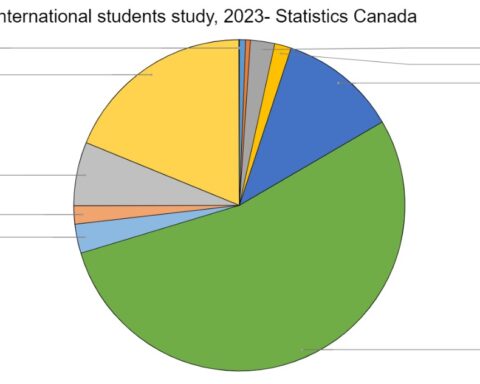Immigrant women and those from visible minority groups were less likely to hold well-paid care positions than their male counterparts during the pandemic, states a new study by Statistics Canada.
The “Women working in paid care occupations” report released today is the first study of its kind “to provide a detailed portrait of paid care workers in Canada,” it states. It also examines how the pandemic has affected the employment of workers in this sector.
The care economy refers to activities related to the provision of care, including care for children, seniors, and people with disabilities, as well as healthcare, education, personal, social and domestic services.
“The aging population and the impact of the COVID-19 pandemic have put a strain on Canada’s healthcare system, and the demand for care work is higher than ever,” said the report’s authors.
“In Canada, unpaid care work accounts for a significant share of caregiving across the country, and while both men and women have increased their unpaid workloads, women are still doing the bulk of this work and spending more time on unpaid care and domestic work than their male counterparts.
“The pandemic has highlighted the importance of crucial paid care occupations, such as nurse aides, orderlies and associates, which are more likely to be women and immigrants, earning low wages, and work part time.”
‘Federation in crisis’
Today’s report comes in the wake of calls by the Canadian Federation of Nurses Unions (CFNU) and the Canadian Nurses Association (CNA) for governments to work “as a federation in crisis” and come up with innovative strategies to fix a health-care system that “is on the brink of collapse.”
In a statement, the CFNU and CNA said rates of anxiety and depression among nurses have increased over 40 per cent during this pandemic.
The groups are calling for financial incentives such as wages and retention bonuses, to encourage senior nurses to remain in practice, targeted loan forgiveness programs and immediate deployment of mental health resources to the front lines and additional efforts to ensure safe patient-to-nurse ratios.
In a similar vein, a recent University of Alberta study found that family caregivers are also suffering high levels of anxiety and depression as a result of the pandemic-induced restrictions and protocols.
The study of family caregivers in Alberta reported that 58 per cent of family caregivers noted a deterioration in their mental health while 48 per cent noted a deterioration in their physical health.
Today’s Statistics Canada report, funded by Women and Gender Equality Canada (WAGE) and using data from the 2016 Census, found that about three million people were employed in paid care occupations, making up nearly one-fifth (19 per cent) of the total employed population in Canada.
Women represented the majority of paid care workers, accounting for three quarters (75 per cent) of all care workers in 2016.
That same year, “almost (four) in 10 female care workers were registered nurses and registered psychiatric nurses, elementary school and kindergarten teachers, nurse aides, orderlies and patient service associates or early childhood educators and assistants. The top care occupations held by men were janitors, caretakers and building superintendents, light-duty cleaners, secondary school teachers or elementary school and kindergarten teachers,” the report states.
Immigrant (under)representation
Immigrants represented 24 per cent of all Canadian workers in the 2016 census. Although they represented a similar proportion of workers in care occupations (25 per cent), they were particularly overrepresented in assisting occupations in support of health services (34 per cent), service supervisors and specialized service occupations (34 per cent) and service support and other service occupations (32 per cent).
In contrast, immigrants were underrepresented in specialized middle management occupations (18 per cent), professional occupations in education services (18 per cent) and law, social, community, and government services (16 per cent).
There were, however, “some notable gender differences related to the types of positions held based on immigrant status or belonging to a visible minority,” the study found.
“For example, a higher proportion of immigrant men than immigrant women were working in well-paid occupations such as professional occupations in nursing (33 per cent vs. 22 per cent) and professional occupations in health (except nursing) (35 per cent vs. 24 per cent).
“By contrast, immigrant women were more likely than their male counterparts to work as executive housekeepers and cleaning supervisors (37 per cent vs. 30 per cent) and in service support and other service occupations (36 per cent vs. 29 per cent).”
“Women from population groups designated as visible minorities were also less likely to hold well-paid positions than their male counterparts.”
For example, Filipino men were “twice as likely to be in professional occupations in nursing (11 per cent) as Filipino women (5 per cent).”
In contrast, Filipino women (12 per cent) were more likely than Filipino men (9 per cent) to work in “care providers and educational, legal and public protection support occupations…such as home child care providers and home support workers, housekeepers and related occupations.”
Also, men “were more likely than women to hold professional occupations in health (except nursing) such as general practitioners and family physicians and specialist physicians” — particularly among South Asian (11 per cent vs. 7 per cent), Chinese (8 per cent vs. 6 per cent) and Arab (5 per cent vs. 2 per cent) populations.
“In general, immigrant care workers were particularly overrepresented in assisting occupations in support of health services (34 per cent), in service supervisors and specialized service occupations (34 per cent) and in service support and other service occupations (32 per cent). By contrast, they were underrepresented in occupations in specialized middle management (18 per cent), professional occupations in education services (18 per cent) and in professional occupations in law, social, community and government services (16 per cent).”
Some other highlights
- Registered nurses and registered psychiatric nurses (9 per cent), elementary school and kindergarten teachers (9 per cent), nurse aides, orderlies and patient service associates (8 per cent) and early childhood educators and assistants (7 per cent) were the most common occupations, accounting for a third of all care workers in 2016.
- Women in care occupations were more likely than their male counterparts to have a college credential as their highest level of education (29 per cent vs. 16 per cent), whereas a larger proportion of men than women held a university certificate, diploma or degree at the bachelor level or above (51 per cent vs. 44 per cent).
- Women in care occupations had lower employment income than men ($59,300 vs. $73,400) on average in 2015.
- The employment of women in care occupations continued to improve, in contrast to men’s employment. Thus, in November 2021, employment among men in care occupations was at a level similar to that in February 2020, whereas for women it was 2 per cent higher.
A multiple-award winning journalist, Fabian Dawson is an internationally acclaimed author, filmmaker and media expert. His work over the last four decades spans the globe and he also serves as a consultant/strategic advisor to a variety of international companies. As deputy editor-in-chief of The Province, part of the Postmedia chain, Dawson led initiatives within a special publications group to provide directed content for a variety of organisations. He was named the 2019 recipient of the Bruce Hutchison Lifetime Achievement Award at Jack Webster Awards. Dawson has been invited by the governments of India, Malaysia, Taiwan, China, Hong Kong and the United States to act as a media observer/advisor on a variety of Asian-Canada issues. Dawson, now operates FD Media, which specializes in harnessing editorial assets to revenue generating opportunities.





